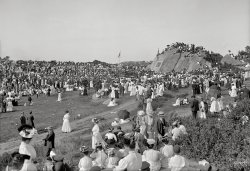
MAY CONTAIN NUTS

Search Shorpy
SHORPY ART

Framed or unframed, desk size to sofa size, printed by us in Arizona and Alabama since 2007. Explore now.
Join and Share
Ad-Free Shorpy
Shorpy is funded by you. Patreon contributors get an ad-free experience.
Learn more.

Recent comments
- Party of Eight?
- Good choice
- Recent view
- Hudson’s Big Store
- Say what??
- Grapes?!
- Just a Great photograph.
- A Beautiful Moment
- Such joy
- Bethune-Cookman University today
- Yellow sky at morning
- Side Winder
- Air Quality?
- Sojourner Truth riot
- None were so blind(ed)
- The less famous sister
- Good ol' days?
- Rise and Fall
- Goo Goo Ga Joob
- Ticket Retention
- Not the only one
- Vagaries of War
- Killed by Amtrak
- Back to the Future
- Wanted --
- If you can't stand the light
- Centralized Traffic Control, I believe
- What's really happening
- Heckuva remote control!
- Sometimes — Things Go Bump!
Member Photos
The Shorpy
Print Emporium
Print Emporium
Search Shorpy
Search results -- 30 results per page
- The Loaves of Summer: 1923
- ... aperture. Shooting in high-contrast dappled shade under trees is extremely hard for correct exposure. This one's very successful.
... Posted by Dave - 08/07/2012 - 2:58am -
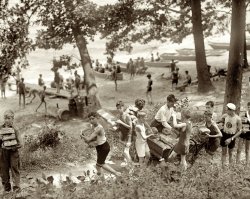
- Forest Coupe: 1926
- ... nineteenth at Lincoln. I've lost many a ball among those trees.
Four-Wheel Brakes The Rickenbacker was the first car to ... Posted by Dave - 05/18/2015 - 11:57am -
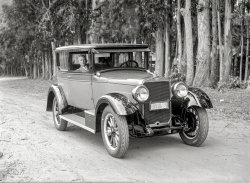
- More Apple Candy: 1940
- ... retired,
Campus culture The white columns and trees to the left give the station's precise location away, as 819 S. Braddock ... Posted by Dave - 01/25/2018 - 6:14pm -
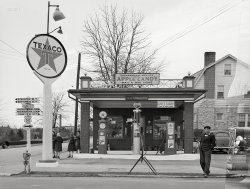
- High Bridge: 1905
- ... self-taught engineer, he started out as an axeman(clearing trees and brush) on the Erie Canal, and advanced to one of the lead engineers. ... Posted by Dave - 06/05/2015 - 11:45am -
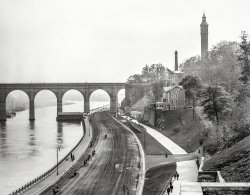
- Woodies Annex: 1926
- ... On Capitol Hill Don't miss the U.S. Capitol behind the trees on the right. Anyone know the address?
Likely Address Based on ... Posted by Dave - 08/08/2012 - 7:34pm -
![Woodies Annex: 1926 Circa 1926. "Woodward & Lothrop warehouse." Manufacturing plant for the long-gone D.C. department store. National Photo glass negative. View full size.
South Capitol, Canal and DThis 1924 ad in the corner gives the address as South Capitol, Canal and D street SW, so maybe below the Rayburn/Longworth office buildings?
[Below we see the reason the photo was taken: To illustrate this newspaper ad from April 1926. Click to enlarge. - Dave]
We need Clint EastwoodTo say "Get off my lawn" instead of having a boring little "Keep off the grass" sign.
On Capitol HillDon't miss the U.S. Capitol behind the trees on the right. Anyone know the address?
Likely AddressBased on South Capital, D, and Canal Sts, and reviewing historical aerials of the area, it appears that the likely address would have been either 400 S Capitol St or 1 D St SE. Until sometime between 1957 and 1963 it looks like the building was still there, and it was cleared with the building of the Interstate 395.
The original block was bounded by S Cap, D, Canal Sts, and NJ Ave SE. Today a a highway ramp and Ivy Pl SE bisect the block. http://goo.gl/maps/xgOeA
(The Gallery, Cars, Trucks, Buses, D.C., Natl Photo, Stores & Markets)](https://www.shorpy.com/files/images/SHORPY_33136u.thumbnail.jpg)
- Meet the Marmon: 1925
- ...
Re: 275 Santa Clara Ave. Could those be the same trees in front of the house 91 years later?
[Looks like the big one at ... Posted by Dave - 05/05/2016 - 2:36pm -
![Meet the Marmon: 1925 San Francisco circa 1925. "Marmon '74' Sedan." Advertised as "a luxurious closed car at practically the cost of an open car." Latest exhibit in the Shorpy Pantheon of Posthumous Phaetons. 5x7 glass negative by Christopher Helin. View full size.
Re: Re: 275 Santa Clara Ave.I doubt that the tree is the same one. The eucalyptus in the original photo is right on the edge of the slope, and the tree in question behind it is significantly further back and closer to the house. In the current street view, the big conifer in question is on the slope's edge where the original eucalyptus stood. But more importantly, tterrace, how the heck did you find the house?!?
[I think it's the conifer's trunk growth. I'd long thought some of these big houses in the Bygone Buggy series were in San Francisco's ritzy St. Francis Wood neighborhood, so my process was to search Bing Map's bird's eye views then check out likely prospects in Google Street View. Oh, the first step was having plenty of time on my hands. -tterrace]
Meh. I remain unconvinced about the tree, but I'm over that. I'm still just incredulous on your house find, no matter how much free time you have! I know I spent too much time last summer looking for this one without success. And now you'll probably show it to us after 5 minutes of effort...
275 Santa Clara Ave.In the elegant St. Francis Wood neighborhood.
Re: 275 Santa Clara Ave.Could those be the same trees in front of the house 91 years later?
[Looks like the big one at right in the street view is there behind the eucalyptus in our photo. -tterrace]
Gone but not goneAutomobile production ceased years ago but Marmon continued on and, after several mutations, is now part of Bershire Hathaway.
(The Gallery, Chris Helin, San Francisco)](https://www.shorpy.com/files/images/SHORPY-966.thumbnail.jpg)
- The 4 Percent: 1923
- ... the same angle via Google Maps street view, as there are trees that block the front of the building.
Casing the Joint The 'Little ... Posted by Dave - 08/07/2017 - 6:08pm -
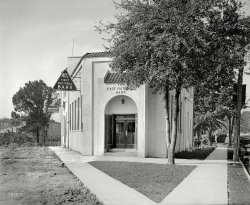
- Texas Drought: 1936
- ... View full size.
I'll meet you by the the two trees in the panhandle, you know, one has a birds nest.
Looks like a ten ... Posted by Dave - 06/18/2018 - 1:19pm -
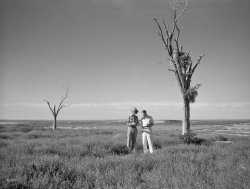
- Tumblr: 1906
- ... before and after photo. Only problem is, there are trees in the way now that might make it difficult to pull off.
Fire damage ... Posted by Dave - 08/24/2014 - 1:24pm -
![Tumblr: 1906 "Union Square with Naval Monument and St. Francis Hotel, San Francisco." Aftermath of the April 18, 1906, earthquake and fire. 8x10 inch dry plate glass negative, Detroit Publishing Company. View full size.
108 yearsWow. Aside from the Dewey Monument, Union Square sure has changed quite a lot since this photo was taken!
All attempts at understatement comedic effect aside, this would make for a fabulous high-quality before and after photo. Only problem is, there are trees in the way now that might make it difficult to pull off.
Fire damage to the (partially completed) Westin St Francis is clearly evident, and it's amazing to me that they just "cleaned her up" and she's still going strong today.
Stunning and timely photo.
[There wasn't any "Westin" back in 1906, although the marketing department for that particular lodging conglomerate is probably thrilled to see people referring to it that way! - Dave]
Scorch marks at every windowof the still-standing St. Francis Hotel. The fire must have been horrible. While across the street, the buildings have toppled. The amazing column dead centre, standing. The foreground a battlefield of bricks. What an incredibly dramatic photo. And so poignant, with today's quake in the region.
+103Below is the same perspective from September of 2009.
(The Gallery, DPC, Fires, Floods etc., San Francisco)](https://www.shorpy.com/files/images/SHORPY-4a13216a.thumbnail.jpg)
- Hangin' on the Porch: 1937
- ... size.
Still there But hard to see for all the trees. It's had some modifications to the stairs and there are no more porches. ... Posted by Dave - 08/08/2013 - 6:28pm -
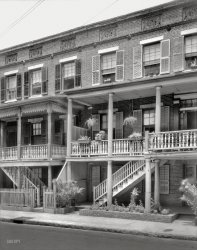
- Out to Lunch: 1908
- ... to have a comparable shot, I think there would still be trees in the way. For once I like the current view better!
View ... Posted by Dave - 08/19/2012 - 3:20pm -
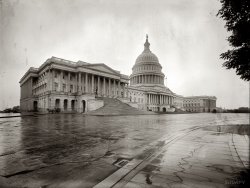
- Getting Hitched: 1925
- ... the current "Book Depot" station still standing today.
Trees have obscured much of the background in this contemporary photo of ... Posted by Dave - 12/11/2014 - 4:14pm -
![Getting Hitched: 1925 Mill Valley, Calif., circa 1925. "Nash touring car with trailer." Outfitted with a patriotic profusion of flags. 5x7 glassneg by Christopher Helin. View full size.
Auto-KampersThe car is towing an Auto-Kamp Trailer, one of the first fold-out campers made.
Mill Valley, that's my homeThis view shows the old Mill Valley train depot at the corner of Miller and Throckmorton Avenues. This depot was torn down in 1928 and replaced with the current "Book Depot" station still standing today.
Trees have obscured much of the background in this contemporary photo of today's Depot (bottom photo below), but the Bank of America in the background of the circa 1925 photo is still standing strong.
[Excellent detective work! I've updated the caption. - Dave]
Mill Valley Fuel CompanyIn the background at right, just where it should be at what is today 71 Throckmorton Ave., though the old building is long gone. You could, however, have bought one of these there, according to the Sausalito News of October 19, 1918.
(The Gallery, Cars, Trucks, Buses, Chris Helin, On the Road)](https://www.shorpy.com/files/images/SHORPY-163-01.thumbnail.jpg)
- New House: 1968
- ... posted previously. The front yard had two tall eucalyptus trees that had been poorly topped several years before we moved in and the trees would snap large limbs that would come crashing down in storms. That ... Posted by Cerrito68 - 11/23/2012 - 10:18pm -
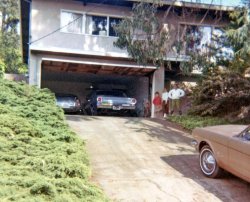
- Cherry Street Bridge: 1909
- ... at the Western Mfg Co.; the moodiness of the outlines of trees and buildings disappearing into the smoke/haze; the grand church; the ... Posted by Dave - 09/18/2016 - 4:13pm -
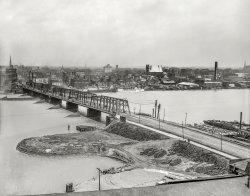
- Runaway: 1916
- ... a rather impressive double-deck grandstand. The stand of trees to the right in the posting and left here gives the spot away. Maybe the ... Posted by Dave - 04/21/2016 - 6:02pm -
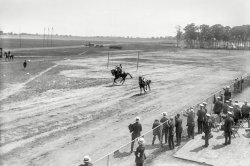
- Levittown PA: 1958
- ... after it was built in 1953. Every house got two fruit trees and two pine trees that were basically single stalk sticks. With no landscaping the lots ... Posted by aenthal - 08/30/2013 - 7:04pm -
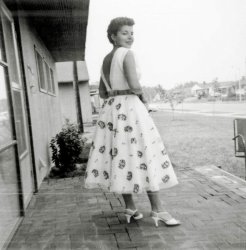
- On the Stump: 1939
- ... "new" growth, he remarks about how all of the old "big" trees are long gone.
(The Gallery, Agriculture, Dorothea Lange, Kids, ... Posted by Dave - 10/05/2017 - 4:03am -
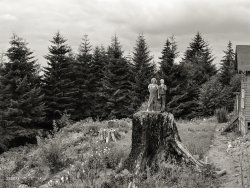
- Out for a Drive
- ... to the Santa Clara Valley to see all the acres of fruit trees in bloom. (This was in the 1940s before it became Silicon Valley.) Notice ... Posted by woodwardave - 09/21/2011 - 9:20pm -
![Out for a Drive From a turn-of-the-century family photo album. Probably taken in Michigan. Can someone identify the automobile? View full size.
Sunday ExcursionI love these old family cars. Back from the times when a Sunday Drive was a leisurely thing. Our father was into Sunday Drives. Sometimes a drive to Sacramento, sometimes to Santa Cruz. Sometimes to the Santa Clara Valley to see all the acres of fruit trees in bloom. (This was in the 1940s before it became Silicon Valley.) Notice the two spare tires. Even in the 1940s a flat tire was a worry on these drives.
Hi-res version?Dave, if you could post a higher-resolution version of the photo, I could try to identify the car. The shape of the grille shell looks slightly familiar, but a higher-res image would help.
[There already is a hi-res version. Click above where it says "View full size." - Dave]
1909 SeldenI found it! It's a 1909 Model 29 Selden touring car; Price $2,000; cape top, $137 extra.
(ShorpyBlog, Member Gallery, Cars, Trucks, Buses)](https://www.shorpy.com/files/images/untitled112shorpy.thumbnail.jpg)
- Ruinas el Carmen: 1915
- ... nearly a mile above sea level and is surrounded by pine trees and volcanoes--decidedly not the typical image one has of a standard ... Posted by Dave - 11/02/2014 - 4:39pm -
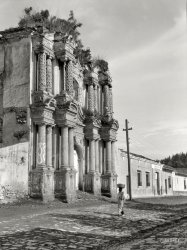
- Shady Lane: 1953
- ... side of the dirt road. It's now completely grown over by trees, but you can still see it on old versions of Google Earth.
Another ... Posted by Dave - 09/01/2015 - 7:07pm -
![Shady Lane: 1953 Columbus, Georgia, circa 1953. "Housing." Visited by the Snow Laundry truck. 4x5 acetate negative from the News Archive. View full size.
I don't careThe setting might be an inspiration for a depressing Tennessee Williams play, but I don't care. The shady lane looks inviting.
Schatulga?This looks very familiar to the tiny community of Schatulga (Shu-taw-ga), that existed up until the late 1990's in Columbus. It was located on Schatulga Road, just north of the railroad crossing on the east side.
I passed here every day for years and would marvel that it looked like it was right out of the 1930s South. One day it just disappeared, except for one house on the left side of the dirt road. It's now completely grown over by trees, but you can still see it on old versions of Google Earth.
Another Story AwaitingIt was a photo very similar to this that got me interested in Lewis Hine's "Mornings On Maple Street" and led me to Shorpy.
[Lewis Hine has been gone for a while. Mornings on Maple Street is the website of Joe Manning. - Dave]
(The Gallery, Columbus, Ga., News Photo Archive)](https://www.shorpy.com/files/images/SHORPY-620.thumbnail.jpg)
- Gaiety Camp: 1910
- ... who will be doing the actual camp work.
Hidden in the trees is the road which leads to the young ladies equivalent of Camp Gaiety. ... Posted by Dave - 12/11/2013 - 11:28pm -
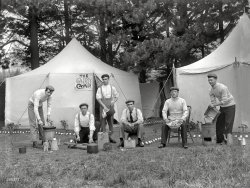
- Veepstakes: 1960
- ... view. You have to stroll a ways up Vermilion to clear the trees, but many of the architectural details on the buildings still match those ... Posted by epaulmiller - 07/16/2016 - 12:57pm -

- Well Connected: 1922
- ... towers rated as much attention as the monuments and cherry trees in those halcyon days of unrestricted airspace.
(Technology, The ... Posted by Dave - 04/24/2013 - 9:05am -
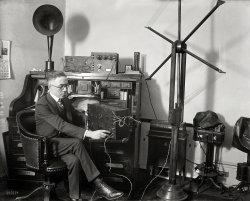
- Apple Story: 1925
- ...
Forty thousand persons, exultant because a million apple trees are in bloom, marched through the streets today with rejoicing for ... Posted by Dave - 07/09/2012 - 10:56am -
![Apple Story: 1925 April 25, 1925. "Apple Blossom Festival at Winchester, Virginia." Our second glimpse at these curious goings-on. National Photo Co. View full size.
Just a wild guess hereI think this depicts a re-enactment of the marriage of Pocahontas (1595-1617) to John Rolfe, widower and tobacco grower, in colonial Virginia in 1614.
[Actually, the kneeling girl is the Queen of the festival, in this case, Miss Eleanor Chiles. She's being greeted by, apparently, the "Minister of the Crown," one Richard H.G. Gray. Those offices are still in use at the Shenandoah Apple Blossom Festival. - tterrace]
Celebrating Dispossession
Washington Post, April 19, 1925.
Winchester Ready to Greet Hosts at Blossom Festival.
“Prince Shenandoah” to Crown Miss Eleanor Chiles, Queen of Fete.
… A colorful festival parade will be held early Friday Afternoon, marching through the gaily decorated streets to the fair grounds, where the pageant, symbolizing the routing of the Indians from the Valley by the white men, will take place. Miss Eleanor Chiles, brunette, daughter of S.M. Chiles, will be crowned by “Prince Shenandoah” on a dais in front of the grandstand. A rythmic dance will follow.
Washington Post, April 25, 1925.
Apple-Blossom Fete Ends With Fireworks
Crown Festival Queen.
Forty thousand persons, exultant because a million apple trees are in bloom, marched through the streets today with rejoicing for nature's promise of a rich harvest. … Just as a valley, rich and fragrant, with a myriad of blooms scenting the air, never seemed more beautiful, so the skies, glorious and blue, never seemed more far. Of the 40,000 persons, some rode in gorgeous floats and other marched; but all were attired in costumes of pink, red, green and white—the colors of the blossoms. …
They marched to the fair grounds, there to crown a queen, Miss Eleanor Chiles, of Frederick county, whose radiant charm personified the unrivaled beauty of the apple blossom. She was attend by twenty princesses, the fairest of the Shenandoah.
Another photo of Ms. ChilesShe appears to be quite the stunner and I think, was representative of an American Indian woman.
(The Gallery, Natl Photo)](https://www.shorpy.com/files/images/SHORPY_13393u.thumbnail.jpg)
- Verily, a Velie: 1919
- ... which had a wonderful hill for winter sledding, as well as trees for climbing.
No front brakes Yet another fancy car with no ... Posted by Dave - 07/10/2015 - 10:07pm -
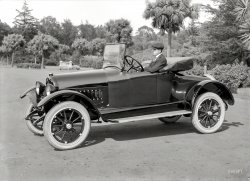
- Gloria Victis: 1903
- ... View full size.
114 Years Later All the trees make it hard to see what the surrounding area looks like.
... Posted by Dave - 03/26/2017 - 2:24pm -
![Gloria Victis: 1903 Baltimore circa 1903. "Confederate Soldiers' and Sailors' Monument, Mount Royal Avenue." Sculptor Frederic Ruckstull's allegorical bronze "Spirit of the Confederacy," whose Latin inscription means "Glory to the Vanquished." 8x10 inch dry plate glass negative, Detroit Publishing Company. View full size.
114 Years LaterAll the trees make it hard to see what the surrounding area looks like.
Odd railing systemThis looks like kind of an inappropriate railing around, what I would think, was an important monument. It looks like it was sloppily enlarged.
[It's a temporary enclosure to protect the freshly-laid sod around the new statue. -Dave]
(The Gallery, Baltimore, Civil War, DPC)](https://www.shorpy.com/files/images/SHORPY-4a10969a.thumbnail.jpg)
- Pioneer Park: 1929
- ... View full size.
View-blocking lives But now it's trees that have unaccountably been allowed to obscure much of the view from up ... Posted by Dave - 10/23/2015 - 8:27pm -
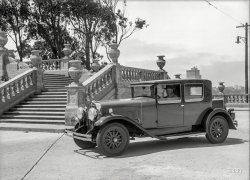
- Maine Woodsmen: 1943
- ... driving...and driving...and all we could see was trees! This might have been around 1968? I'm not sure if Brown's still owns ... Posted by Dave - 01/13/2018 - 9:11pm -
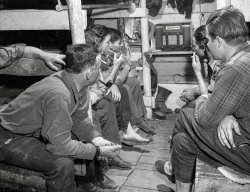
- Humboldt Bay
- ... That area is more formally known as Arcata Bay. Redwood trees in the surrounding hills were logged and rivers and streams carried silt ... Posted by kevhum - 05/18/2007 - 12:48am -
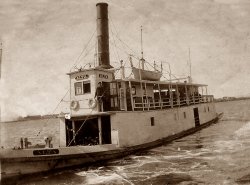
- The Big Reveal: 1907
- ... it looks today. Couldn't quite get the same angle due to trees obstructing the view.
(The Gallery, DPC) ... Posted by Dave - 09/27/2016 - 1:40pm -
